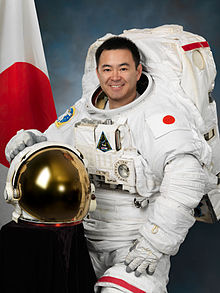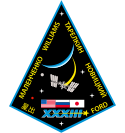Akihiko Hoshide
| Akihiko Hoshide (星出彰彦) | |
 Akihiko Hoshide | |
| Född | 28 december 1968 Tokyo, Japan |
|---|---|
| Tid i rymden | 340 dagar, 11 timmar, 42 minuter |
| Antal rymdpromenader | 4 |
| Rymdpromenadtid | 28 timmar, 17 minuter |
| Uppdrag | STS-124, Sojuz TMA-05M, Expedition 32, Expedition 33, Expedition 65, Expedition 66 |
| Uppdragsemblem | |
Akihiko Hoshide (japanska: 星出彰彦 Hoshide Akihiko), född 28 december 1968 i Tokyo, är en japansk astronaut och ingenjör.
Hoshide utsågs till japansk kandidat som besättningsman på den internationella rymdstationen (ISS) av JAXA år 1999 och fullgjorde sin utbildning till astronaut två år senare. I juni 2008 reste han till ISS ombord på rymdfärjan Discovery, där han deltog i arbetet med att integrera instrumentmodulen Kibō i rymdstationen. I juli 2012 reste han till ISS med en Sojuz-raket. Han tillbringade omkring fyra månader på ISS och gjorde tre rymdpromenader.[1]
År 2021 deltog han i Expedition 65/66 som besättningsman och befälhavare. Han utförde bland annat experiment i Kibō-modulen och gjorde en rymdpromenad under sin 198 dagar och 10 timmars långa vistelse.[1]
Eftermäle
Asteroiden 14926 Hoshide är uppkallad efter honom.[2]
Rymdfärder
- Discovery - STS-124
- Sojuz TMA-05M, Expedition 32, Expedition 33
- SpaceX Crew-2, Expedition 65, Expedition 66
Källor
- ^ [a b] ”HOSHIDE Akihiko” (på engelska). https://humans-in-space.jaxa.jp/en/astronaut/hoshide-akihiko/. Läst 16 februari 2024.
- ^ ”Minor Planet Center 14926 Hoshide” (på engelska). Minor Planet Center. https://www.minorplanetcenter.net/db_search/show_object?object_id=14926. Läst 8 september 2024.
|
Media som används på denna webbplats
The official mission insignia for International Space Station (ISS) Expedition 66, designed to resemble US highway route 66
- The Expedition 66 patch celebrates the continued utilization of the International Space Station as a path for human and scientific space exploration.
- Its shape reflects the Route 66 highway sign, which once guided an earlier expansion into distant, remote lands. The arc of the Earth’s atmosphere is reminiscent of the well-known stop-motion photos taken by astronauts and cosmonauts of the Earth in eclipse.
- Two future destinations are depicted, the Moon resting inside one of the numerals, and Mars to the right. A multicolored bridge containing the colors of each of this mission’s international partner’s flags (Russia, Germany, France, Japan, and the United States) draws the viewer from the perimeter of the patch into the numeral 66 just as the space station bridges the gap from low-Earth orbit to these distant exploration destinations.
The Expedition 33 patch depicts the International Space Station (ISS) orbiting around the Earth, and into the future. The national flags of Japan, Russia, and the United States of America represent the crew of Expedition 33, which consists of six astronauts and cosmonauts from Japan, Russia and the United States. The five white stars represent the partners participating in the ISS Program – Canada, European countries, Japan, Russia and the United States. Expedition 33 will continue the work of the previous thirty-two expedition crews on board the multi-national laboratory in areas such as biology and biotechnology, earth and space science, educational activities, human research, physical and material sciences, and technology development and demonstration.
International Space Station (ISS) Expedition 65 mission insignia
- The International Space Station Expedition 65 patch depicts the space station as it appears during the time the crew will be onboard. The space station flying over the Earth represents the overall reason for having a space station; to benefit the world through scientific research and international cooperation in space. When this expedition begins, the space station will have provided continued human presence in space for more than twenty years. Blue, the background color of the patch, symbolizes reliability.
- The stars represent the crew onboard the space station, as well as mission control centers located on three continents. Those stars, in that field of blue, also symbolize the thousands of space workers throughout the space station partnership who continue to contribute to the success of our International Space Station.
The SpaceX Crew-2 official insignia
- The determined expression of the Dragon reflects the strength of the team and their contribution to the exploration of space. The five large stars represent the five partner space agencies coopering the International Space Station program. Designed by Gregory Manchess
Emblem of Nasa's STS-124 mission.
- The STS-124/1J patch depicts the Space Shuttle Discovery docked with the International Space Station (ISS). STS-124/1J is dedicated to delivering and installing the Japanese Experiment Module (JEM) known as Kibo (Hope) to the ISS. The significance of the mission and the Japanese contribution to the ISS is recognized by the Japanese flag depicted on the JEM Pressurized Module (JPM) and the word Kibo written in Japanese at the bottom of the patch. The view of the sun shining down upon the Earth represents the increased "hope" that the entire world will benefit from the JEM's scientific discoveries. The JPM will be the largest habitable module on the ISS and is equipped with its own airlock and robotic arm for external experiments. In addition to delivering and installing the JPM, the STS-124 crew will relocate the JEM Logistics Pressurized (JLP) module to its permanent home on the zenith side of the JPM. During three planned space walks, the crew will perform external ISS maintenance and JPM outfitting, as well as extensive robotic operations by the ISS, space shuttle, and JEM robotic arms. It will be the first time that three different robotic arms will be operated during a single space flight mission.
This patch represents the 32nd expedition to the International Space Station (ISS) and the significance of the science being conducted there for current and future generations. The arch shape of the patch symbolizes the "doorway" to future space exploration possibilities. The ISS, an orbiting laboratory above the Earth, provides a unique perspective for Earth observation and monitoring. The flame depicts the pursuit of knowledge and highlights the importance of education as the key to future human space flight. The astronaut symbol circles the Earth, acknowledging the work of all astronauts, past, present, and future. The names of each crew member located on the border of the patch are written to honor the various cultures and languages on the mission. The three flags also depict the home countries of the Expedition 32 crew members and signify the collaborative ISS partnership of 15 countries working as one.
Japan Aerospace Exploration Agency (JAXA) astronaut Akihiko Hoshide, attired in a training version of his Extravehicular Mobility Unit (EMU) spacesuit.






